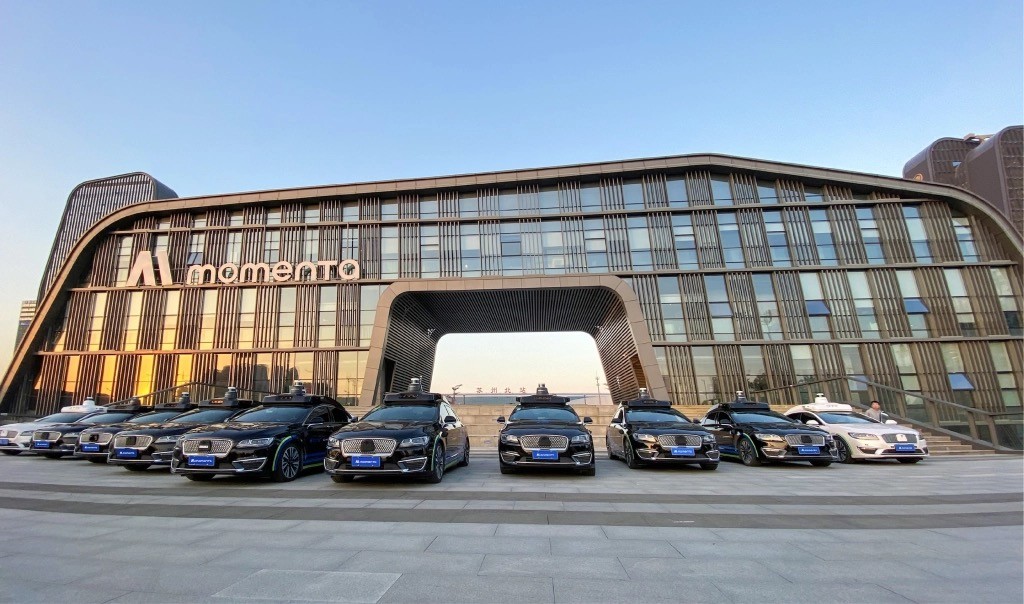忘掉駕校吧。在不久的將來,,教汽車開車比教人開車更有用,。
如果不留意,可能意識不到人工智能的存在,,但人工智能正在上海和蘇州的大街上讓汽車教汽車如果自動駕駛,,這是中國最大的汽車制造商上汽集團(tuán)(SAIC Motor)和總部位于蘇州的人工智能公司Momenta的合作成果。
從2021年12月到2022年3月,,這兩家公司在上述兩個特大城市共投放了60輛無人駕駛出租車,,以檢驗這項技術(shù)的使用前景。已經(jīng)有數(shù)千名中國乘客通過手機叫車搭乘了這些無人駕駛出租車出行,,車內(nèi)仍配有人類操作員,,萬一出現(xiàn)緊急情況可以控制車輛,。Momenta表示,,80%的乘客在初體驗后至少又約過兩次他們的車,證明了這項服務(wù)的“巨大潛力”,。
現(xiàn)在,,該公司正在努力向通用汽車(General Motors)、梅賽德斯-奔馳(Mercedes-Benz)和其他數(shù)十家汽車制造商推廣這項技術(shù),,目標(biāo)是在未來幾年內(nèi)推出乘用車,。但Momenta的首席執(zhí)行官曹旭東表示,首先,,必須要積累1000億英里的駕駛數(shù)據(jù),。

包括Cruise和Argo AI在內(nèi),,美國和世界各地有幾十家公司都在開發(fā)下一代自動駕駛汽車系統(tǒng),。但Momenta的戰(zhàn)略定位或許可以更快地實現(xiàn)這一目標(biāo)。和其他公司一樣,,Momenta的機器學(xué)習(xí)系統(tǒng)也會對人類駕駛員成百上千萬次的操作進(jìn)行觀察記錄,,但它沒有以此為基礎(chǔ)編制駕駛規(guī)則代碼,而是讓這些數(shù)據(jù)直接指導(dǎo)其他汽車,。
與競爭對手相比,,該公司還有兩個關(guān)鍵優(yōu)勢:可以獲得高清的中國公路圖,與高銷量汽車制造商達(dá)成了重要合作關(guān)系,,這些車企本就已經(jīng)在收集大量汽車駕駛數(shù)據(jù),。通用汽車、梅賽德斯-奔馳,、豐田(Toyota),、汽車零部件供應(yīng)商博世(Bosch)等公司已向Momenta投資超過10億美元,推動自動駕駛的加快發(fā)展,。
“解決可擴(kuò)展的自主問題面臨巨大挑戰(zhàn),。“曹旭東向本刊表示,,“客戶一旦看到我們能夠為大規(guī)模生產(chǎn)程序開發(fā)算法,,就能理解我們的能力,。”
傳統(tǒng)的基于規(guī)則的機器學(xué)習(xí)方法的編碼邏輯是讓汽車對特定刺激做出反應(yīng),?!叭绻l(fā)生了X,就做Y動作,?!泵苄髮W(xué)機械工程副教授拉姆·瓦蘇代萬說,“如果汽車攝像頭看到停車標(biāo)志,,就停車,。”開發(fā)人員將各種操作規(guī)則編寫到軟件中,,比如改變車道時該做什么,,如何在靜止的車輛周圍移動等等。例如,,當(dāng)汽車左轉(zhuǎn)時,,汽車的內(nèi)置程序會先計算其軌跡,汽車會相應(yīng)減速,。
但只要開過車的人都知道,,路況并不總是這么直來直去的。舉一個經(jīng)典例子:一個小孩突然沖出來追球,,司機要決定是剎車還是轉(zhuǎn)向,。大多數(shù)公司預(yù)先設(shè)定的策略都是變道,但Momenta的數(shù)據(jù)會教會汽車考慮其他因素,,比如天氣和時間,。
這就是為什么Momenta放棄了基于規(guī)則的算法,從零開始訓(xùn)練汽車,?!癕omenta做的是真正的人工智能,”瓦蘇代萬說,。

“數(shù)據(jù)驅(qū)動”的端到端學(xué)習(xí)方法實現(xiàn)起來要困難得多,,成本也高得多,。該公司合作伙伴生產(chǎn)的汽車在路上行駛的數(shù)百萬英里可以幫助汽車學(xué)習(xí)在各種環(huán)境中駕駛,與已經(jīng)投入了數(shù)十億美元用于大規(guī)模生產(chǎn)自有自動駕駛汽車的車企合作是生產(chǎn)如此大量數(shù)據(jù)的唯一方法,。
Momenta方法的優(yōu)勢在于它可以處理更復(fù)雜的情況和細(xì)微差別,。“你怎么能確定你已經(jīng)預(yù)先把每一條規(guī)則都設(shè)定好了?”瓦蘇代萬說,?!半y點在于你需要大量標(biāo)注過的數(shù)據(jù),,才能為每一種駕駛場景編制規(guī)則。即使這樣,,也仍然可能存在某種你沒有編進(jìn)自動駕駛堆棧中的場景,。”
自動駕駛市場正在迅速增長,。Momenta預(yù)計,,到2025年,將有近6000萬輛汽車配備2級或3級高級駕駛員輔助系統(tǒng),,這是進(jìn)階到全自動駕駛汽車的跳板,。
今年3月,美國聯(lián)邦監(jiān)管機構(gòu)規(guī)定,,制造商不再需要為全自動駕駛汽車配備方向盤,、制動踏板或某些其他手動駕駛控制裝置。這為美國汽車制造商開始在公共道路上大規(guī)模測試自動駕駛車型鋪平了道路,。
通用汽車旗下的Cruise和Alphabet旗下的Waymo拿到了加州機動車輛管理局(Department of Motor Vehicles)的許可,,可以在有限條件下在公共道路上運營無人駕駛出租車。特斯拉首席執(zhí)行官埃隆·馬斯克在今年4月的季度財報電話會議上表示,,該公司計劃在2024年前開發(fā)一款不配備方向盤或制動踏板的自動駕駛出租車,。馬斯克說:“我認(rèn)為這絕對會推動特斯拉大幅增長?!保ㄘ敻恢形木W(wǎng))
譯者:Agatha
忘掉駕校吧,。在不久的將來,教汽車開車比教人開車更有用,。
如果不留意,,可能意識不到人工智能的存在,但人工智能正在上海和蘇州的大街上讓汽車教汽車如果自動駕駛,,這是中國最大的汽車制造商上汽集團(tuán)(SAIC Motor)和總部位于蘇州的人工智能公司Momenta的合作成果,。
從2021年12月到2022年3月,這兩家公司在上述兩個特大城市共投放了60輛無人駕駛出租車,,以檢驗這項技術(shù)的使用前景,。已經(jīng)有數(shù)千名中國乘客通過手機叫車搭乘了這些無人駕駛出租車出行,車內(nèi)仍配有人類操作員,,萬一出現(xiàn)緊急情況可以控制車輛,。Momenta表示,80%的乘客在初體驗后至少又約過兩次他們的車,,證明了這項服務(wù)的“巨大潛力”,。
現(xiàn)在,該公司正在努力向通用汽車(General Motors),、梅賽德斯-奔馳(Mercedes-Benz)和其他數(shù)十家汽車制造商推廣這項技術(shù),,目標(biāo)是在未來幾年內(nèi)推出乘用車,。但Momenta的首席執(zhí)行官曹旭東表示,首先,,必須要積累1000億英里的駕駛數(shù)據(jù),。
包括Cruise和Argo AI在內(nèi),美國和世界各地有幾十家公司都在開發(fā)下一代自動駕駛汽車系統(tǒng),。但Momenta的戰(zhàn)略定位或許可以更快地實現(xiàn)這一目標(biāo),。和其他公司一樣,Momenta的機器學(xué)習(xí)系統(tǒng)也會對人類駕駛員成百上千萬次的操作進(jìn)行觀察記錄,,但它沒有以此為基礎(chǔ)編制駕駛規(guī)則代碼,,而是讓這些數(shù)據(jù)直接指導(dǎo)其他汽車。
與競爭對手相比,,該公司還有兩個關(guān)鍵優(yōu)勢:可以獲得高清的中國公路圖,,與高銷量汽車制造商達(dá)成了重要合作關(guān)系,這些車企本就已經(jīng)在收集大量汽車駕駛數(shù)據(jù),。通用汽車,、梅賽德斯-奔馳、豐田(Toyota),、汽車零部件供應(yīng)商博世(Bosch)等公司已向Momenta投資超過10億美元,,推動自動駕駛的加快發(fā)展。
“解決可擴(kuò)展的自主問題面臨巨大挑戰(zhàn),?!安苄駯|向本刊表示,“客戶一旦看到我們能夠為大規(guī)模生產(chǎn)程序開發(fā)算法,,就能理解我們的能力,。”
傳統(tǒng)的基于規(guī)則的機器學(xué)習(xí)方法的編碼邏輯是讓汽車對特定刺激做出反應(yīng),?!叭绻l(fā)生了X,就做Y動作,?!泵苄髮W(xué)機械工程副教授拉姆·瓦蘇代萬說,“如果汽車攝像頭看到停車標(biāo)志,,就停車,。”開發(fā)人員將各種操作規(guī)則編寫到軟件中,,比如改變車道時該做什么,如何在靜止的車輛周圍移動等等,。例如,,當(dāng)汽車左轉(zhuǎn)時,,汽車的內(nèi)置程序會先計算其軌跡,汽車會相應(yīng)減速,。
但只要開過車的人都知道,,路況并不總是這么直來直去的。舉一個經(jīng)典例子:一個小孩突然沖出來追球,,司機要決定是剎車還是轉(zhuǎn)向,。大多數(shù)公司預(yù)先設(shè)定的策略都是變道,但Momenta的數(shù)據(jù)會教會汽車考慮其他因素,,比如天氣和時間,。
這就是為什么Momenta放棄了基于規(guī)則的算法,從零開始訓(xùn)練汽車,?!癕omenta做的是真正的人工智能,”瓦蘇代萬說,。
“數(shù)據(jù)驅(qū)動”的端到端學(xué)習(xí)方法實現(xiàn)起來要困難得多,,成本也高得多。該公司合作伙伴生產(chǎn)的汽車在路上行駛的數(shù)百萬英里可以幫助汽車學(xué)習(xí)在各種環(huán)境中駕駛,,與已經(jīng)投入了數(shù)十億美元用于大規(guī)模生產(chǎn)自有自動駕駛汽車的車企合作是生產(chǎn)如此大量數(shù)據(jù)的唯一方法,。
Momenta方法的優(yōu)勢在于它可以處理更復(fù)雜的情況和細(xì)微差別?!澳阍趺茨艽_定你已經(jīng)預(yù)先把每一條規(guī)則都設(shè)定好了?”瓦蘇代萬說,。“難點在于你需要大量標(biāo)注過的數(shù)據(jù),,才能為每一種駕駛場景編制規(guī)則,。即使這樣,也仍然可能存在某種你沒有編進(jìn)自動駕駛堆棧中的場景,?!?/p>
自動駕駛市場正在迅速增長。Momenta預(yù)計,,到2025年,,將有近6000萬輛汽車配備2級或3級高級駕駛員輔助系統(tǒng),這是進(jìn)階到全自動駕駛汽車的跳板,。
今年3月,,美國聯(lián)邦監(jiān)管機構(gòu)規(guī)定,制造商不再需要為全自動駕駛汽車配備方向盤,、制動踏板或某些其他手動駕駛控制裝置,。這為美國汽車制造商開始在公共道路上大規(guī)模測試自動駕駛車型鋪平了道路。
通用汽車旗下的Cruise和Alphabet旗下的Waymo拿到了加州機動車輛管理局(Department of Motor Vehicles)的許可,可以在有限條件下在公共道路上運營無人駕駛出租車,。特斯拉首席執(zhí)行官埃隆·馬斯克在今年4月的季度財報電話會議上表示,,該公司計劃在2024年前開發(fā)一款不配備方向盤或制動踏板的自動駕駛出租車。馬斯克說:“我認(rèn)為這絕對會推動特斯拉大幅增長,?!保ㄘ敻恢形木W(wǎng))
譯者:Agatha
Forget driver’s ed. Soon teaching a car to drive will be more effective than teaching a human.
Artificial intelligence may be invisible to the unsuspecting eye, but it’s already at work on city streets in Shanghai and Suzhou, where cars are teaching each other how to drive themselves, thanks to a partnership between SAIC Motor, China’s largest automaker, and Suzhou-based artificial intelligence company Momenta.
Together the companies deployed 60 robotaxis across the two megacities from December 2021 through March 2022 to validate the technology for use in the cars of the future. Using a smartphone app, thousands of city dwellers in China completed their errands by summoning the robotaxis staffed with human operators who could take control in a potential emergency. Momenta says that 80% of riders used the app at least twice after their initial trial, demonstrating the “vast potential” of the service.
Now the company is working toward scaling its technology for General Motors, Mercedes-Benz, and dozens of other automakers with the goal of launching inside passenger vehicles within the next several years. But first, Momenta CEO Cao Xudong says, it must amass 100 billion miles of driving data.
Dozens of companies in the U.S. and around the world, including Cruise and Argo AI, are developing next-generation systems for autonomous cars. But Momenta’s strategy may be positioned to bring it to fruition faster. Like others, its machine learning observes and clocks millions of maneuvers made by human drivers, but instead of using those actions as the basis for hardcoded driving rules, Momenta lets the data instruct the other cars directly.
The company also has two key advantages over competitors: access to China’s high-definition road maps and significant partnerships with mass-market carmakers who are already collecting data from tens of thousands of cars on the road. General Motors, Mercedes-Benz, Toyota, auto parts supplier Bosch, and others have invested more than $1 billion in Momenta to accelerate the development of autonomous driving.
“The challenge of solving scalable autonomy is massive,” Xudong tells Fortune. “When customers see we are able to develop algorithms for mass production programs, they understand our capability.”
The traditional rules-based approach to machine learning programs the cars to respond to a stimulus with a specific action. “If X happens, you do Y,” says Ram Vasudevan, associate professor of mechanical engineering at the University of Michigan. “If the car’s camera reads a stop sign, you stop.” Developers hardcode the software with rules for various maneuvers such as what to do when changing lanes or how to move around a stationary vehicle. When making a lefthand turn, for instance, the car is programmed to precompute its trajectory and slow down accordingly.
But anyone who has driven a car knows that traffic situations aren’t always so straightforward. Take the classic example: A child runs out into the street in pursuit of a ball, leaving the driver to decide whether to brake or swerve. Most companies pre-program a lane-change maneuver, but Momenta’s data teaches the car to consider other factors, such as the weather and time of day.
That’s why Momenta forgoes rules-based algorithms to train cars from scratch. “What Momenta is doing is truly artificial intelligence,” Vasudevan says.
The “data-driven,” end-to-end learning approach is much harder and more expensive to pull off. The millions of miles its partners log on the road help cars learn to drive in a range of environments, and the only way to generate such volumes of data is to collaborate with automakers who are already investing billions of dollars toward mass producing their own autonomous vehicles.
The advantage of Momenta’s approach is that it can handle more complex situations and nuances. “How do you know that you’ve preprogrammed all the rules out there?” Vasudevan says. “The challenge is that you’re going to need lots of labeled data in order to create a rule for every driving scenario. Even after all of that, there may be a situation that you haven’t programmed into your autonomous stack.”
The market for autonomous driving is growing rapidly. By 2025, Momenta expects that nearly 60 million vehicles will come equipped with Level 2 or 3 advanced driver assistance systems, the stepping stone to fully self-driving cars.
In the U.S., federal regulators ruled in March that manufacturers no longer need to equip fully autonomous vehicles with steering wheels, brake pedals, or certain other manual driving controls. This paves the way for American automakers to begin testing their models at scale on public roads.
GM-owned Cruise and Alphabet’s Waymo received permits from the California Department of Motor Vehicles to operate robotaxis on public roads under limited conditions, and Tesla CEO Elon Musk said during the company’s quarterly earnings call in April that the automaker plans to develop a robotaxi without a steering wheel or pedals by 2024. "I think that that really will be a massive driver of Tesla's growth,” Musk said.






